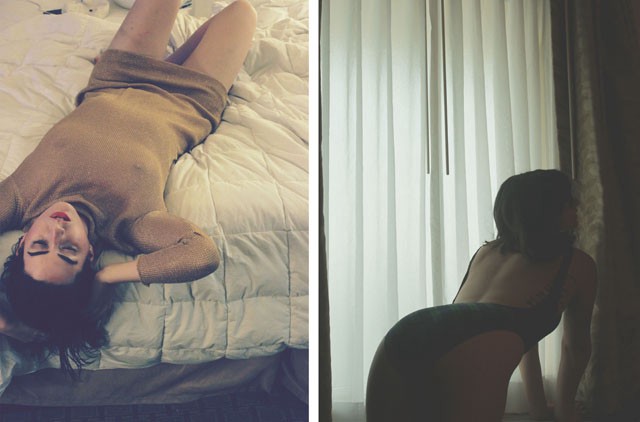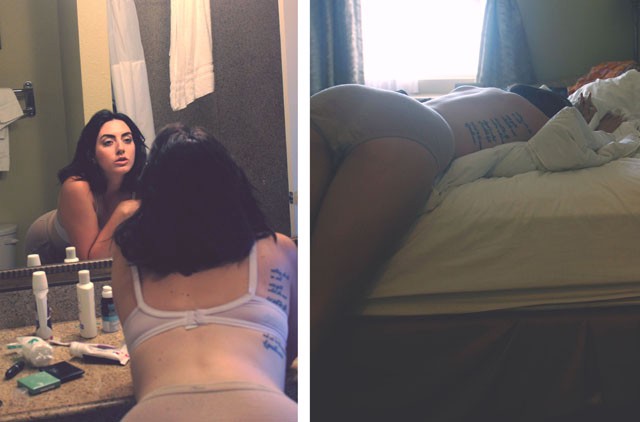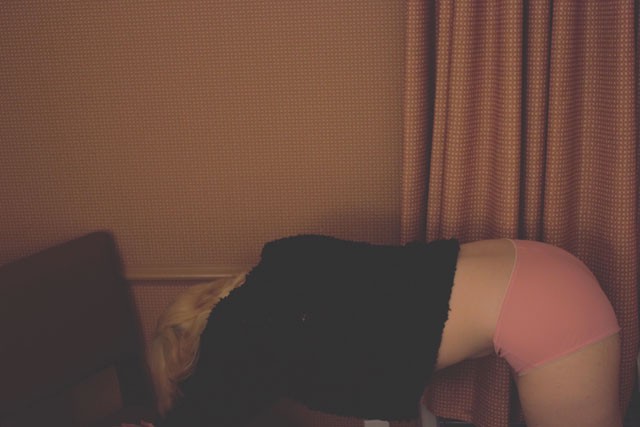All My Sexts Live In Texas
by Casie Brown

I put on a high-cut plaid one-piece swimsuit that was probably too small for me; it sliced my ass into quarters. The past two weeks I’d kept my hotel room at a temperature permitting the least amount of clothing. Fluorescent-kissed cheeks were constant, most of my nights spent swimming laps in the indoor pool and then writhing alone, wet atop a milky white and freshly laundered comforter, to whatever FKA Twigs song turned me on most that day. It was Texas in August, which basically means it was hot.
As I napped the heat crept through the walls. After a moist awakening, I went to the window and pressed the plus sign on the AC, until a dull vibration began and air spat upwards towards my not-yet hardened nipples. Orange light caught in the frosted window, looking onto the presumably less-than-desirable view of the Quality Inn parking lot. I set up my tripod.
In the past year I’ve been taking ‘titillating’ images of myself, by myself, and posting them across the World Wide Wanton Web. Perhaps for you, my reader, or you, my Instagram follower, these photos are simply a series of sexualized selfies, a case of naked narcissism. A couple of peach bum emojis and a few humorous hashtags would lead you to read them as such.
Somewhere in the past year or two, while growing out my bush, I’ve also grown into this self-serving sexualization. The greatest acceptance and understanding I’ve come to know of my motivations, emotions, and body have come through dissecting and representing my sexual experiences of the past, present, and imagined future. I may lol at the untitled folder on my desktop — -a growing collection of carefully constructed intimate moments, snapped by the lover living in the ten-second self-timer countdown — -but that doesn’t devalue their importance to my creative self and sexual expression.
My series of selfies was a reaction to my own creative laziness. In my early twenties, I kept .JPGs bookmarked on my computer; catalogued the fiction and non-fiction I read; worshipped, like all the young women in my “Image in Narrative” university course, Cindy Sherman’s Untitled Film Stills. I knew the inventory I was building was entirely images of women in the flux of routine lust, a sexuality of the mundane. I didn’t realize until later that it was actually the other way around. The women in these specific images weren’t possessed but were possessors — -that’s what I liked about them. Their sexualization wasn’t just for mindless and appetite consumption. They saw the creepy uncle that is the traditional male gaze cataloguing their bodies and experience through a keyhole.They stared back in critique through the peephole and presented these images themselves. But that took some time for me to figure out.
I wanted to know what nipples — -my nipples, to be exact — -looked like through a Lurex dress I was trying on, what my shoulders and the back of my head looked like as I was getting fucked from behind. At the time, all those images were held captive by the eyes of a handful of lovers (which, in my case, were men).
I tried to subtly coax my lovers into playing photographer — -if unzipping a pair of 1970s-era Levis at the speed of a topless tortoise, while he stands above you in bed, iPhone in hand, hovering between the weather and camera apps, is subtle. These images never materialized, vanishing from my mind as quickly and unapologetically as the plethora of whiskey dicks that followed. The visuals I wanted to create, and could only envision through the eyes of these men, were put to bed, and not in the way I had intended at all.
When I turned twenty-six, something changed. Or maybe something didn’t change. The real-life girls I looked up to (mainly via Blogspot domains) credited the images of themselves to their boyfriends or husbands. Perpetually single, I was disheartened. I scheduled a man to swoop in, take me as his muse, and create the intimate portraits I had already been sketching in my head. This man stood me up. Permanently. This man never even existed. The crescendo-ed ticking of some auto-biological clock inside me finally realized this after hastily asking an ex for all of his iPhone photos of me from before our breakup, in hopes of finding something similar to what I desired. After sending two photos of me sitting in bed, in a pre-pubescent sized neon swimsuit holding two hotdogs, I consulted my Canon instruction manual and began creating these images myself. I found out I, quite literally, do not need no one-minute man. After all, if a woman wearing a cheek-choking swimsuit bends over to adjust the air conditioning, and a man isn’t there to see it, does it still exist?

Cut to age twenty-seven. My nondescript hotel room outside of Houston. I’m in a different bodysuit, black with a snap-crotch. Over the past two years I’ve gotten used to the anonymity of military precision bedsheets and popcorn ceilings. Work trips are regular, lengthy. Aside from a few Facebook chats or texts or Instagram posts, I’m in limbo. Someone else cleans up my eaten bags of Doritos and re-stocks my toiletries. When I finish my workday, which involves sorting through thousands of pounds of 1970s polyester shirts with pit stains, inhaling unthinkable amounts of dust, I normally just want to blow my nose (you’d be surprised what comes out after sitting on mounds of vintage clothing) and binge watch Sabrina the Teenage Witch.
This night was a little different. I’d been quasi-broken up with — -if you can call it that. Really just the definitive end of a brief mutual attraction that could’ve gone one way or the other. I decide to watch Wim Wenders’ Paris, Texas, because, as the saying goes, when in Texas. I search for a working stream of the film, struggling to close the Facebook chat window where it all just happened. A man, Harry Dean Stanton, walks across a classically depicted Texan landscape. Vast and barren desert. My hotel remains flanked by large Erin Brockovitch-esque oil drums and fast food chains. He stumbles into a desolate bar and shoves ice chips in his mouth.
I switch tabs and scroll up through our Facebook chat history. It starts off (not) innocently in May with him noting he was “really liking those pictures.” It was 7a.m. and I replied naively: “What pictures?”
“Those hot ones.”
Thank you for your random unsolicited male opinion, I think. Thank you for being so kind as to group these individual images into a Criterion Collection of jerkoff material for yourself. Switch Tabs. Stanton collapses out of frame and a busty centerfold poster hangs on the wall in his place.
Any disappointment I had about the dissolve of the relationship quickly turned to molten anger. It had taken three months of him laying low, engaging in non-threatening chit-chat every now and then, and you know, treating me like a human being rather than fantasy fuck toy, for me to entertain the idea of a relationship or hook up with him. His profuse apologies whenever I aggressively called him out on his objectifying behavior helped, but didn’t take away the initial ‘slut’ sting I felt. I deleted our conversation, undid the irritating snaps of my bodysuit, and went back to the movie.
We learn that Stanton’s character, Travis, has abandoned his wife and child and gone MIA for the last several years. With his son, he sets out to find his estranged wife, Jane (Nastassja Kinski), finding her in Houston, working at dimly lit gentlemen’s club specializing in the thing male-gaze cream-dreams are made of: a blackened hallway with curtained booths, each featuring a one-way mirror. While the customers peer into this ‘performance’ space, the women within the booths only see their mirrored reflections.
The second booth that Travis walks into is unremarkably (but for me, uncannily) marked Hotel on a nameplate affixed to the door. Surrounded by salmon walls and hot pink furniture, Jane enters, dissolving into the set’s sexually charged atmosphere in her fuchsia mohair sweater, and takes a seat directly facing the gaze we, as an audience, share with Travis (and presumably any other man that has paid for a peek that week).
She explains the set up of the booth to Travis saying, “You realize that I can’t see you, even though you can see me? Well, that takes a little getting used to.” And it does.

The morning after I’d posted the swimsuit/air conditioner photo. My workweek normally consists of dust-filled pores and the same pair of utilitarian Target-brand leggings, so I tend to revel in the routine of ‘getting ready.’ I stood, hips pressed against the long bathroom counter that was too big for one person, but allowed me to keep my makeup scattered comfortably for my three-week stay. I leaned in to make sure I’d blended the concealer I put on the little red indents of my nostrils. While I noticed that pore refiner I bought was actually working, I took in the composition of this scene. The putty beige color of the walls, which I’d never thought aesthetically pleasing, were highlighted by the same pot light that contoured my face as I tilted it upward, checking any hairs on my upper lip. My favorite pair of off-brand granny panties smoothly faded into the granite they pressed against.
I set up my camera on a towel rack above the toilet, aimed at the mirror, quickly repositioning my body to where it had been.
Like Jane, I saw the three walls that enclosed the mirror, making up my set, and the mirror that enclosed my body. My mirror wasn’t false, but I still couldn’t see through it. I took some variations, and, satisfied with what I’d shot, put on a white long sleeved tunic and lay across the washed bed spread. Just a virginal angelic vision in white, checking her instagram, because her coworker had texted to say she needed fifteen more minutes.
Clicking the orange notification on my direct Insta folder, I saw a screen grab of my last post with the option ‘Report Inappropriate’ visible. The caption: “Where r u?”
“Texas.” I replied.
“Nice ass,” he typed back.
Shame about presenting myself and my body in such a sexualized way set in. I found myself humoring the men who decided it was necessary to assert the experience of feminine sexuality I was projecting with their words.
That’s not to say that the images I was putting forward weren’t sexualized; they were. That’s how the shame started. Was I just be pandering to the perverse objectified vision of femininity that dominates our western culture? Was I rightfully earning looks of disdain from my feminist peers? Was I ‘asking for’ the responses I had been getting from male followers? The real question: was my iPhone screen the false mirror of a Texas strip club?
Critic Stefan Kolditz said that Paris, Texas is partially about “the images that men make of women.” As I watched Jane sit in that booth, the hairs of her knit sweater suggestively kissing her collar bone, patiently awaiting whatever form of demoralizing male attention might come her way, I was enraged. It felt impossible to maintain agency when you can’t see through the mirror in front of you. To be able to look into the eyes of the voyeur at least affords an opportunity to intercept the reception with intent.
Without the eyes, the image becomes object. We become soundboards for their interpretations and commentary. The reflection that Jane sees of herself in the booth, a photo I take of my southern regions in a Southern region, is now up for grabs by whoever can DM “boner” the fastest. This realization struck me at a vulnerable moment. My humming air conditioning unit wasn’t powerful enough to defuse the shame. It was thick and heavy. Maybe this aspect of my self, which I felt defined my personhood (on my own terms), would be impossible to share from a personal and feminist viewpoint, when a the tradition of a male gaze clung like mildew on it’s lens.
Wenders’ doesn’t present this gaze blindly. It’s written all over Travis’ face as he watches Jane, and even when he doesn’t. Lighting and camera angles reveal a line of sight that’s often just implied or imposed. As Travis watches the image of his wife through the one-way mirror, his own is caught by the same glass and projected back towards the audience (and himself). In their following scene, Travis revisits the booth (her set is now a kitchen, for all your oppressed domesticized nightmares). He tells Jane his version of the breakdown of their marriage. Head down, her glare pierces strands of blonde hair that have fallen in her face, to the mirror in front of her, and then she tells her own. The desk lamp, lighting what presumably is a Xeroxed list of the services/women available, is turned from a downward position to light Travis’ profile. Jane, never having left the small radius of light her comically small set affords her, is now pressed against the mirror, and for the first time, looking through it.
On my last Saturday in Texas, I got drunk off a $7 litre of wine and signed onto Skype with an ex. Sickly beige walls flushed to fuchsia as the camera indicator glowed green. A booth of my own, only I could see, hear, and direct my viewer. The window on the right corner of the screen acted as my mirror, while body transmitted across state lines. I controlled the image he saw. My proxy to the camera, the angles and lighting, were all of my making, and I could watch them shift, in turn noting any shift in him as well. Consensual, reciprocal gaze. Until he asked me to turn around. The mirror becomes one sided. I lose any control over his line of sight. Lights out on his half of the booth, the voyeur disappears from the screen and we’re left with the original image of Jane entering the booth. I conceded, reluctantly, forfeiting my gaze.
With my back turned, I hear the familiar and abrasive sound of a computer generated shutter closing. Command-Shift-3. A screengrab captures my sexual agency, and I’m back at the start. The image belongs to him and I’m mortified. Even if I asked to see it (which, after an interrogation, he swears it didn’t turn out), and had it in my possession, it still wouldn’t be my mine. It’s a skewed version of what I once wished for. To see myself, sexualized, from a male eye — -or in this case, his macbook. Only now, I don’t want it like that.
I close Skype, and shut off my lights. My booth is blackened for the moment, no one looks in. I reach beside me for my phone, my face a silhouette of blue as I slide through my apps and open instagram. Voyeuristic privilege might be granted by the screen — be it a oneway peep show mirror, or an Instagram feed. But looking to the photos, I read my own body while the sound of an interstate muffles its way through the hotel curtains. I open them, the sound rushes in. I realize there’s no need to press my face against the glass. I don’t need to see the other side of the booth. The images are already doing that. I yank them shut as my upturned breasts say goodnight to a Texas sky.
Casie Brown is a writer, stylist and vintage clothing picker from Toronto. Her favorite things that start with the letter P are Pizza, Paul McCartney and Pussy Power. You can find all three on her Twitter and Instagram accounts, @casieleeanne.